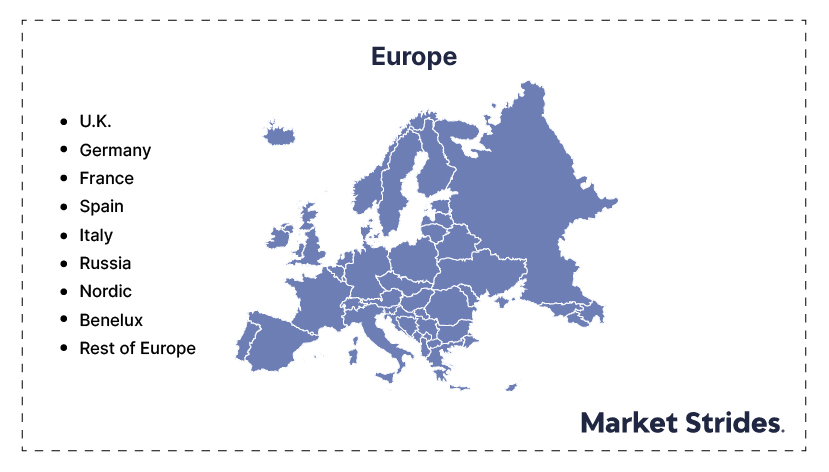The Europe hypothyroidism drugs market size is expected to grow at a CAGR of 4.05% during the forecast period (2025–2033). The market is witnessing steady growth due to the surging prevalence of thyroid disorders, increasing healthcare awareness, and advancements in diagnostic technologies. Moreover, growing research in personalized medicine and improved pharmaceutical formulations are expected to shape market expansion in the coming years.
Hypothyroidism drugs are medications used to treat an underactive thyroid, a condition where the thyroid gland does not form enough hormones. The primary treatment is levothyroxine, a synthetic form of thyroxine (T4), which helps restore normal hormone levels and metabolism. Other medications include liothyronine (T3) and natural desiccated thyroid (NDT) derived from animal thyroid glands. These drugs help alleviate symptoms such as fatigue, weight gain, and depression. Treatment is typically lifelong, with dosage adjustments based on thyroid function tests. Proper management of hypothyroidism prevents complications like goiter, heart issues, and myxedema, a severe form of thyroid hormone deficiency.
The escalating prevalence of hypothyroidism in Europe serves as a primary driver for the market. Studies indicate a considerable portion of the European population suffers from undiagnosed hypothyroidism, particularly subclinical cases. For instance, a comprehensive meta-analysis published in PubMed reported that the overall prevalence of hypothyroidism in Europe is approximately 3.05%, with undiagnosed cases constituting about 4.94% of the population.
This underdiagnosis underscores the necessity for increased screening and awareness, leading to a higher demand for effective pharmaceutical interventions. Additionally, factors such as an aging population, iodine deficiency, and autoimmune disorders contribute to the rising incidence of thyroid dysfunctions. As awareness grows and diagnostic methods improve, the identification and treatment of hypothyroidism are expected to surge, propelling the market forward.
Despite the positive outlook, the market faces challenges related to stringent regulatory frameworks governing drug approval and commercialization in Europe. The rigorous evaluation processes ensure patient safety and drug efficacy but can lead to delays in bringing new therapies to market.
Pharmaceutical companies must navigate complex regulations, which may require substantial time and financial investment. These hurdles can impede the swift introduction of innovative treatments, potentially limiting market growth. Moreover, variations in regulatory requirements across European countries add to the complexity, necessitating a harmonized approach to facilitate smoother market entry for new hypothyroidism drugs.
The advent of personalized medicine presents a significant opportunity within the Europe market. Tailoring treatments based on individual patient profiles, including genetic makeup and specific disease characteristics, can enhance therapeutic efficacy and minimize adverse effects. The European Commission has been instrumental in promoting personalized medicine through initiatives like the European Partnership for Personalised Medicine, launched in October 2023. This partnership aims to consolidate precision medicine approaches within health systems, fostering continuous improvement and innovation.
Furthermore, research into genetic markers and patient-specific factors influencing thyroid hormone metabolism is paving the way for customized treatment plans. Pharmaceutical companies investing in personalized medicine approaches can develop targeted therapies, address unmet medical needs, and differentiate their products in a competitive market. This shift towards individualized care is anticipated to improve patient outcomes and drive market expansion.
| ATTRIBUTES | DETAILS |
|---|---|
| Study Period | 2021-2033 |
| Historical Year | 2021-2024 |
| Forecast Period | 2025-2033 |
| By Drug Type |
|
| By Route of Administration |
|
| By Distribution Channel |
|
| Regional Insights |
|
Levothyroxine dominates the Europe market due to its status as the standard treatment for thyroid hormone replacement. The segment's growth is driven by its proven efficacy, widespread availability, and cost-effectiveness. According to the European Thyroid Journal, levothyroxine prescriptions have risen steadily, with an increasing preference for branded and bioequivalent generic versions.
The aging population, rising prevalence of hypothyroidism, and improved diagnosis rates contribute to higher demand. Moreover, advancements in dosage precision and extended-release formulations are enhancing patient adherence, further fueling market expansion. Pharmaceutical companies continue to invest in product innovation, ensuring sustained growth in this segment.
The oral route of administration is the most preferred for hypothyroidism drugs due to its convenience, effectiveness, and patient compliance. Levothyroxine, the leading drug, is primarily available in tablet and capsule forms, making it easy to administer and dose-adjust. Physicians and endocrinologists favor oral formulations as they ensure steady hormone absorption.
Hospital pharmacies play a fundamental role in the distribution of hypothyroidism drugs, especially for newly diagnosed patients and those requiring specialized care. The segment is growing due to the increasing hospitalization rates of elderly patients and those with severe thyroid disorders. Hospitals also stock advanced formulations, including intravenous levothyroxine for emergency cases such as myxedema coma.
Moreover, collaborations between hospitals and pharmaceutical companies ensure a steady supply of high-quality drugs. The rise in thyroid disease awareness campaigns by healthcare institutions further strengthens the role of hospital pharmacies in patient education and medication adherence, fostering segment expansion across Europe.
Europe holds a substantial share of the global hypothyroidism drugs market. This significant share is attributed to the notable prevalence of thyroid disorders and a robust healthcare infrastructure. According to an article published in PubMed, in Europe, the estimated prevalence of overt hypothyroidism ranges from 0.2% to 5.3% in the general population. Also, gender disparities are notable in this region; women are disproportionately affected, with a prevalence rate of 13.3%, compared to 4.2% in men.
Additionally, geographical variations exist within Europe.
Age is also a contributing factor to the surging incidence of hypothyroidism in this region, as the incidence of this disease surges with advancing age. Europe is experiencing a significant demographic shift characterized by an aging population. As of January 1, 2024, the European Union (EU) had an estimated population of 449.3 million people, with more than one-fifth (21.6%) aged 65 years and over. This trend is projected to continue, with older individuals expected to constitute close to 30% of the European population by 2050. This is estimated to add to the surging burden of the disease, thereby driving the demand for hypothyroidism drugs in this region.
Furthermore, the lower cost of labor and raw materials in certain European countries has attracted foreign investments, further bolstering the market share. The European Thyroid Association (ETA) plays a pivotal role in promoting research and education, contributing to improved diagnosis and management of thyroid disorders across the region. As awareness and diagnostic capabilities continue to advance, the Europe market is poised for sustained growth in the coming years.

Request Table of Contents (TOC), Please Fill below form



